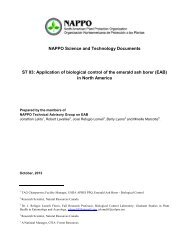Phosphine Fumigation of Grain - nappo
Phosphine Fumigation of Grain - nappo
Phosphine Fumigation of Grain - nappo
You also want an ePaper? Increase the reach of your titles
YUMPU automatically turns print PDFs into web optimized ePapers that Google loves.
NAPPO TREATMENT PROTOCOLS<br />
TP No. 03<br />
<strong>Phosphine</strong> <strong>Fumigation</strong> <strong>of</strong> <strong>Grain</strong> or <strong>Grain</strong> Products for Control<br />
<strong>of</strong> Stored Product Pests<br />
The Secretariat <strong>of</strong> the North American Plant Protection Organization<br />
1431 Merivale Road, 3 rd Floor, Room 309<br />
Ottawa, Ontario, Canada, K1A 0Y9<br />
October 19, 2009
Name <strong>of</strong> treatment<br />
<strong>Phosphine</strong> fumigation <strong>of</strong> grain or grain products for control <strong>of</strong> stored<br />
product pests<br />
Active ingredient Aluminium and magnesium phosphide (produces phosphine gas: PH 3 )<br />
Treatment type<br />
Chemical<br />
Target pest Various storage insects infesting grain and grain by-products as<br />
indicated in the product label.<br />
Target regulated articles Raw, processed and milled grain<br />
Treatment schedule<br />
Other relevant<br />
information<br />
References<br />
Varies depending on type and size <strong>of</strong> storage area, and temperature <strong>of</strong><br />
the product. Applicators will follow the directions outlined on the product<br />
label which has been approved by the each country’s pesticide<br />
regulatory authority (United States Environmental Protection Agency, the<br />
Canadian Pest Management Regulatory Agency or the Mexican<br />
Comisión Federal para la Protección contra Riesgos Sanitarios).<br />
Recirculation <strong>of</strong> the fumigant is an important option in controlling storage<br />
pests in grain and grain by-products. Detailed technical information on<br />
process is available in the Federal <strong>Grain</strong> Inspection Service treatment<br />
manual.<br />
NA<br />
2
Feasibility and applicability<br />
Procedure for carrying out the phytosanitary treatment<br />
The chemical is applied typically in solid form as either an aluminium or magnesium phosphide<br />
formulation (other gaseous formulations are available that include phosphine gas but these have<br />
not been widely adopted in grain shipments). Upon contact with ambient moisture, the formulation<br />
generates phosphine gas and an inert powder residue. The application is normally done in an<br />
enclosed environment. The formulation can be applied either directly, or in paper sleeves or<br />
sachets to facilitate recovery <strong>of</strong> residual powder. After the prescribed exposure period, the<br />
fumigated product is aerated to remove the phosphine gas.<br />
Cost <strong>of</strong> typical treatment facility and operational running costs if appropriate<br />
The usual application takes place in existing facilities (e.g. shipholds, storage facilities, etc). Cost <strong>of</strong><br />
product and application is variable and affected by several factors (volume, location, type <strong>of</strong> facility,<br />
product availability, etc.).<br />
Commercial relevance, including affordability<br />
The chemical has a long history <strong>of</strong> commercial feasibility. The United States Department <strong>of</strong><br />
Agriculture (USDA) developed procedures for in-transit ships fumigation <strong>of</strong> grain with phosphine<br />
over 30 years ago. This practice has since been successfully used on U.S. grain export shipments<br />
to meet contract requirements and in some cases address specific phytosanitary concerns. USDA<br />
records indicate that historically about 50% <strong>of</strong> U.S. grain shipments are fumigated in-transit with<br />
phosphine gas.<br />
Extent to which other NPPOs have approved the treatment as a phytosanitary measure<br />
United States, Canada and Mexico all recognize the use <strong>of</strong> phosphine gas as an effective<br />
phytosanitary treatment for infestations in grain and grain-related products.<br />
Availability <strong>of</strong> expertise needed to apply the phytosanitary treatment<br />
Application techniques are widely known and fairly routine. A wide range <strong>of</strong> commercial applicators<br />
are available to properly and effectively apply the chemical.<br />
Versatility <strong>of</strong> the phytosanitary treatment<br />
Highly versatile. It can be used to treat a wide range <strong>of</strong> grain and agricultural products stored in a<br />
variety <strong>of</strong> containers/conveyances.<br />
The degree to which the phytosanitary treatment complements other phytosanitary<br />
measures<br />
The chemical is used when a visual examination <strong>of</strong> the product for phytosanitary purposes reveals<br />
the presence <strong>of</strong> regulated insects, or to prevent development <strong>of</strong> latent infestation.<br />
3
















